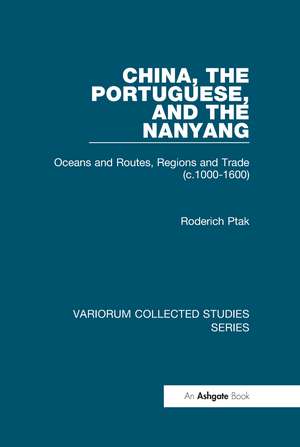China, the Portuguese, and the Nanyang: Oceans and Routes, Regions and Trade (c.1000-1600): Variorum Collected Studies
Autor Roderich Ptaken Limba Engleză Hardback – 25 mai 2004
Din seria Variorum Collected Studies
- 9%
 Preț: 938.85 lei
Preț: 938.85 lei -
 Preț: 311.41 lei
Preț: 311.41 lei -
 Preț: 351.48 lei
Preț: 351.48 lei -
 Preț: 313.38 lei
Preț: 313.38 lei -
 Preț: 386.77 lei
Preț: 386.77 lei -
 Preț: 325.68 lei
Preț: 325.68 lei -
 Preț: 396.00 lei
Preț: 396.00 lei -
 Preț: 312.75 lei
Preț: 312.75 lei - 9%
 Preț: 1041.23 lei
Preț: 1041.23 lei -
 Preț: 258.66 lei
Preț: 258.66 lei -
 Preț: 299.55 lei
Preț: 299.55 lei - 9%
 Preț: 938.08 lei
Preț: 938.08 lei -
 Preț: 343.33 lei
Preț: 343.33 lei -
 Preț: 311.18 lei
Preț: 311.18 lei - 9%
 Preț: 937.13 lei
Preț: 937.13 lei -
 Preț: 351.41 lei
Preț: 351.41 lei -
 Preț: 320.00 lei
Preț: 320.00 lei - 34%
 Preț: 764.20 lei
Preț: 764.20 lei - 23%
 Preț: 315.48 lei
Preț: 315.48 lei - 36%
 Preț: 740.06 lei
Preț: 740.06 lei - 34%
 Preț: 764.20 lei
Preț: 764.20 lei - 34%
 Preț: 680.73 lei
Preț: 680.73 lei - 26%
 Preț: 247.40 lei
Preț: 247.40 lei - 34%
 Preț: 485.78 lei
Preț: 485.78 lei - 38%
 Preț: 766.91 lei
Preț: 766.91 lei - 34%
 Preț: 767.07 lei
Preț: 767.07 lei - 34%
 Preț: 764.20 lei
Preț: 764.20 lei - 34%
 Preț: 769.51 lei
Preț: 769.51 lei - 38%
 Preț: 769.85 lei
Preț: 769.85 lei - 34%
 Preț: 826.68 lei
Preț: 826.68 lei - 25%
 Preț: 225.28 lei
Preț: 225.28 lei - 25%
 Preț: 225.54 lei
Preț: 225.54 lei - 34%
 Preț: 736.38 lei
Preț: 736.38 lei - 34%
 Preț: 738.43 lei
Preț: 738.43 lei - 25%
 Preț: 226.52 lei
Preț: 226.52 lei - 33%
 Preț: 491.66 lei
Preț: 491.66 lei - 34%
 Preț: 485.78 lei
Preț: 485.78 lei - 34%
 Preț: 485.78 lei
Preț: 485.78 lei - 36%
 Preț: 739.17 lei
Preț: 739.17 lei - 38%
 Preț: 766.34 lei
Preț: 766.34 lei - 31%
 Preț: 473.94 lei
Preț: 473.94 lei - 18%
 Preț: 843.61 lei
Preț: 843.61 lei - 38%
 Preț: 774.91 lei
Preț: 774.91 lei - 38%
 Preț: 769.92 lei
Preț: 769.92 lei - 34%
 Preț: 764.20 lei
Preț: 764.20 lei - 51%
 Preț: 485.78 lei
Preț: 485.78 lei - 36%
 Preț: 488.49 lei
Preț: 488.49 lei - 34%
 Preț: 769.10 lei
Preț: 769.10 lei - 38%
 Preț: 766.99 lei
Preț: 766.99 lei - 18%
 Preț: 1019.01 lei
Preț: 1019.01 lei
Preț: 652.84 lei
Preț vechi: 985.02 lei
-34% Nou
Puncte Express: 979
Preț estimativ în valută:
124.92€ • 130.78$ • 103.36£
124.92€ • 130.78$ • 103.36£
Comandă specială
Livrare economică 17-31 martie
Doresc să fiu notificat când acest titlu va fi disponibil:
Se trimite...
Preluare comenzi: 021 569.72.76
Specificații
ISBN-13: 9780860789239
ISBN-10: 0860789233
Pagini: 320
Dimensiuni: 150 x 224 x 25 mm
Greutate: 0.45 kg
Ediția:1
Editura: Taylor & Francis
Colecția Routledge
Seria Variorum Collected Studies
Locul publicării:Oxford, United Kingdom
ISBN-10: 0860789233
Pagini: 320
Dimensiuni: 150 x 224 x 25 mm
Greutate: 0.45 kg
Ediția:1
Editura: Taylor & Francis
Colecția Routledge
Seria Variorum Collected Studies
Locul publicării:Oxford, United Kingdom
Cuprins
Contents: Introduction; Structural Issues and Trade: Ming maritime trade to southeast Asia, 1368-1567: visions of a system; Sino-Portuguese relations circa 1513/14-1550s; China's medieval fanfang - a model for Macau under the Ming?; Camphor in east and southeast Asian Trade, c. 1500: a synthesis of Portuguese and Asian sources. The Perception of Space and Sailing Routes: Quanzhou: at the northern edge of a southeast Asian 'Mediterranean'; Südostasiens Meere nach chinesischen Quellen (Song und Yuan); Jottings on Chinese sailing routes to southeast Asia, especially on the eastern route in Ming times. Islands and Regions: Die Paracel- und Spratly-Inseln in Sung-, Yüan- und frühen Ming-Texten: ein maritimes Grenzgebiet?; Hainans Außenbeziehungen während der frühen Ming-Zeit; Possible Chinese references to the Barus Area (Tang to Ming); Wang Dayuan on Kerala; Index.
Recenzii
'... this is a very important collection of essays for specialists of maritime Asia, who will find it invaluable to their work.' International Journal of Maritime History 'The depth of knowledge and range of interest displayed is impressive...' Bijdragen tot de Taal-, Land- en Volkenkunde 'Following the tradition established by Paul Elliott and the finest western Sinologists, his studies are erudite, rigorous and demonstrate his eye for detail.' Oriente 'The present volume is [...] a very successful attempt to review sources under new questions and to introduce some hitherto neglected aspects of China's maritime trade, both in the concrete (commodities, trade relations, etc.) and in the more abstract, conceptual sense (spatial concepts, etc.).' SOAS Bulletin
Descriere
Under the Song, Yuan and Ming dynasties, China's maritime trade went through several stages of rapid expansion. This concerns both activities initiated by the central government and private seafaring: Chinese ships would sail to ports in Southeast Asia and the Indian Ocean, and foreign merchants would come to China, often declaring themselves as tribute envoys. In the early 16th century, the Portuguese made contact with the Middle Kingdom, leading to the foundation of Macao in the 1550s. The present volume, the third collection by Roderich Ptak, explores important structural features related to China's maritime ventures and Luso-Chinese relations. It also discusses the perception of maritime space in late medieval Chinese texts and the importance of trade routes, especially the so-called eastern route from Fujian via Luzon to the Sulu 'zone'. The third section presents different 'key' regions as seen through Chinese eyes: Hainan, the coral island in the South China Sea, Barus on Sumatra, and finally Wang Dayuan's chapters on the Kerala coast.
